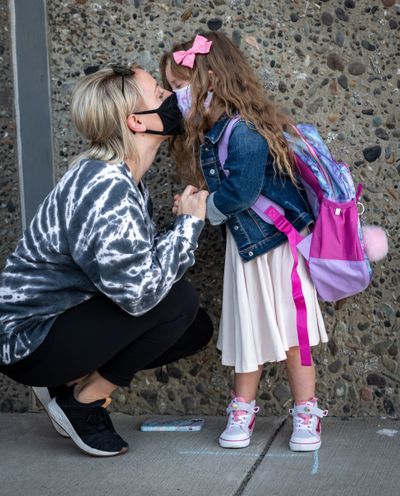Enrollment drops significantly in Spokane Public Schools and other local districts, especially in kindergarten

Around the state – but especially in Eastern Washington – public school districts are seeing enrollment declines as families seek other options because of the COVID-19 pandemic.
Fewer students may translate into lost revenue and jobs.
Data released Wednesday by the Office of Superintendent of Public Instruction reported that 31,000 fewer students are enrolled statewide this year than in September 2019. That’s a 2.8% decrease from last year’s total enrollment of 1.1 million.
And while the impact varied widely by district, most districts in Spokane County lost even more. At Spokane Public Schools, enrollment is down 5.7% – a loss of 1,698 students over last year.
Roughly a third of the decline was attributed to families of kindergartners opting to delay their child’s entry for a year, or pursue other options.
“They didn’t want this to be their beginning learning experience,” said Adam Swinyard, superintendent at Spokane Public Schools.
The reasons for the enrollment declines run the gamut. At all grade levels, parents feared exposure to the virus and elected to home-school; others chafed at the idea of committing to distance learning and placed their children in private schools or parent-driven learning pods.
It was the same story in the West Valley School District, where kindergarten enrollment has plummeted 20% from a year ago.
While hoping that COVID-19 rates would fall and children could return to class, many parents didn’t decide until late in the process. When the district committed to begin the year with distance learning only, many opted for home instruction.
According to West Valley Superintendent Kyle Rydell, some parents said, “‘Hey, my kid’s birthday is in the summer, so I’m going to wait.’ ”
Meanwhile, the county’s second-largest district, Central Valley, lost only 2.3%, or 324 students from last year, while Mead enrollment dropped by 486 students, or 4.8%.
Among the other large districts in Spokane County, Cheney lost a mere 1.6%, or 78 kids, while East Valley saw a staggering drop of 10% and neighboring West Valley’s enrollment fell 7.7%.
However, those numbers are skewed by other factors – namely residential growth in Central Valley and the booming Cheney-Airway Heights area.
“East Valley and us, we’re pretty landlocked,” Rydell said.
Other local districts suffering heavy declines included Nine Mile Falls (9.1%), Freeman (7.2%) and Medical Lake (5.3%).
Barring action by the Legislature, those numbers will translate into a loss of revenue.
Schools are provided state funding through the Prototypical School Funding Model. Developed by the Legislature, it determines how much funding each school will be provided in order to pay for staffing, materials and supplies.
For example, an elementary school of 500 students is allocated about 34 full-time equivalent (FTE) teaching staff for grades K-3. Schools are provided more or less funding for staff FTE, materials and supplies based on the number of students enrolled.
When a student leaves a district for any reason, the district will end up losing a portion of its state funding if that student doesn’t return or is not replaced by a different student.
A loss of 30 students from that school would translate into two or three lost jobs, though perhaps some would be regained with a big influx of kindergartners next year.
“Counts are taken every month, and if these trends continue, many of our districts will need to make adjustments in the short-term even as they plan for booming kindergarten and first grade classes next year,” said Chris Reykdal, the state superintendent of public instruction.
“We will continue working with the Legislature and our congressional delegation on solutions to these unique challenges,” Reykdal said.
The state is also seeing a COVID-related shift in alternative learning experience (ALE) courses, which are public education courses where some or all instruction is delivered outside of a regular classroom schedule.
Compared to September of last year, ALE programs statewide experienced a nearly 50% increase in student enrollment, increasing from roughly 30,000 students to 44,000.
Statewide, about one-third (more than 11,000 students) of the total decrease is attributed to kindergarten-age children not enrolling or delaying their kindergarten start.
By grade level, kindergarten saw the largest decrease in enrollment – 14% – from a year ago. Across the board, the declines leveled off at higher grades.
“At the secondary level, our numbers were pretty comparable to last year’s,” Rydell said.
The declines are also a national phenomenon.
“We are not alone in this,” Reykdal said. “As our nation continues to fight the spread of COVID-19, states across the country are seeing changes in K–12 enrollment as families make decisions about the safest and most effective learning environments for their children.”